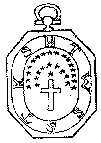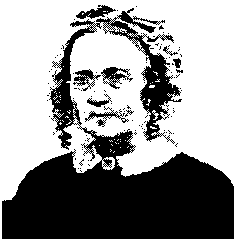
150 Years AgoJames F. Reed at the
Battle of Santa Clara
Links to other Utah Crossroads pages:
 Kristin Johnson's Donner Party Page Kristin Johnson's Donner Party Page
|

Pueblo de San Jose,
12th January, 1847.
Captain John A. Sutter
Dear Sir: By this time you have heard of the battle of Santa Clara,
which came off on the 2d. inst. between the United States forces and the Californians.
Report reached this place about Christmas that the insurgents in the number of 300 or 400
had collected in the redwoods, some twenty five miles distant. On receipt of this
information Lieutenant W. Pinckney, who commands here, dispatched a courier to Monterey to
inform Captain Maddox and requested him to come up the coast by way of Santa Cruz in the
pass, there to remain and if possible to intercept the enemy if they should retreat that
way, while Captain Weber would go to Sanchez' ranch, within twenty-five miles of Yerba
Buena, where he expected mounted volunteers to be sent from the latter place by order of
Captain Mervine, who also was made acquainted by Pinckney with the position of the enemy.
We started (Weber's company), I having the command as First Lieutenant;
proceeded to Sanchez'; from there to the Mission Dolores; from that place Weber went to
Yerba Buena, and after waiting two or three days was reenforced by thirty-two marines,
eight artillerists commanded by Captain Marsten and, I think, seventeen mounted volunteers
of Captains Smith's and Martin's companies. Both gentlemen were present, and we had about
twenty-eight men, making in all eighty-five men, with one piece of artillery. There was a
request made to Captain Marsten that I should return with the marines and artillery, but I
think by an order which Marsten received he was to proceed to the pueblo. However, we, the
mounted men, or nearly all of us, cut loose from the marines and took to the mountains to
find the Californians, and at the northwest corner of the redwoods came on their evacuated
encampment.
We took trail, pursued them toward the Santa Clara Mission. In the
evening we came up again with the marines, encamped at a place called the Sheep Farm, ten
miles from this place. We, however, left the trail but a short distance from the camp, and
on our way toward the mission fell in with it again when Captains Weber, Smith and Martin
took in detached parties, about twenty-one men, to find the location of the enemy, while
the rest of the forces moved onward.
We had not traveled over four miles when our advance guard reported that
the advance of the enemy was in sight. On receipt of this Captain Marsten directed me to
take as many men as I thought prudent to reconnoiter, which I did, and found the
Californians lodged in a point of timber on the right and somewhat in front, with their
scouts a little distance on a small plain, galloping, whooping and daring us for cowards
to come on. When I had reconnoitered and found the position of the foe I halted the men
and rode back to Captain Marsten to inform him , and I requested him to let me advance
with the mounted troops to take possession of the woods on the right and bring on the
engagement in our own mode of fighting, which he refused, stating at the same time he
would have to wait the arrival of the scouts, Weber, Smith and Martin. In a short time
they came in, when Weber's company advanced by order. Then commenced the play. We soon
routed them (the enemy) from the woods, when we were on foot, firing from trees. Afterward
we mounted and took position in two divisions, one on the right and the other on the left
of the artillery and marines. Captains Smith's and Martin's companies were as rear guards.
By this time the firing was general, and as we advanced the enemy gave way, but charging
at times in beautiful style (they are, indeed, fine-looking horsemen), retreating and
charging alternately until we came to a muddy piece of ground on the bank of a little
branch, where it was nearly knee deep. There our horses could with difficulty get along,
owing to the poor state in which they were from past service.
At this place the Californians made a desperate effort to make a
complete surround. Finding us all huddled together in the mud, they all commenced firing,
particularly on the right. When I commanded the second division of Captain Weber's
company, nearly three-fourths of the enemy were popping away in fine style, and I do
assure you we returned the compliments without much delay. Here one of the marines was
slightly wounded on the head. Every now and then the cannon would discharge at them.
Finally we drove them from the field. Their numbers (without a caballada, horses for
remounts) were 100. Our of our eighty-five we had to place over twenty as guard on our
loose horses.
At night the Californians sent in a flag of truce, sueing for terms with
us, which were sent to Yerba Buena, and before the answer returned, Captain Maddox came
from the Pass, where he had waited two or three days. It was in the evening when he came
upon the enemy's camp before they were aware, and would have dashed into them in an
instant had they not been expert in raising the white flag. He told me he never saw such
an uproar as his appearance made. Finally he came to our quarters at the mission, about
two miles from the enemy, when the courier arrived from Yerba Buena. The conditions were
submitted to them, and after some time to deliberate they came to terms and laid down
their arms on the 7th instant, and were permitted to disperse.
At first, the enemy would not admit that any were killed, but since the
treaty they admit three killed and five wounded; and today there has been found one of
their people on the plains nearly eaten by the wolves.
I think that there were more killed. Bartlett and the rest of the
prisoners were released at the time of the surrender of arms was made; however, Bartlett
was paroled when our flag of truce went out to meet the flag of the Californians next day
after the battle.
The sickness has abated considerable within the last two weeks with the
late emigration. There have been a great many deaths, principally females and children.
Since I left your hospitable house I have been scarcely out of my
saddle. I have been riding all the time, often twenty-four hours, before we would eat
anything, and at other times forty hours before we could have an opportunity of sleeping.
It has rained on us two days and nights out of three, wet and drenched, like so many rats.
We would unsaddle and lie down under a tree, or along a pole fence, or by an old corral.
The majority of the females of the Californians in the country had left
their houses before the fight on the Santa Clara plains. A number of Spaniards from this
place and vicinity were engaged in it.
Dear sir, I am heartily glad that I had such an opportunity to fight for
my country. I feel by so doing I have done my duty and no more; but I am still ready to
take the field in her cause, knowing that she is always right. I tell you, my friend, many
were the dodges I made with my head from the balls that whistled by me, some almost
touching my left arm; a gentleman's right and a ball passed through between our hands
[sic]. We soon gave them an exchange, and I called to me a Delaware Indian who had a rifle
that would carry up well; he fired, and I think wounded one of them.
Every man in the fight acted well his part. The reason that there are so
few killed was because we could not get close to them. Their horses were fine, while ours
were broke down.
From Edwin A. Sherman, "An Unpublished Account of the Battle of
Santa Clara, Written by John [sic] Frazier Reed Using His Saddle Horn as a Desk." San
Francisco Chronicle, September 4, 1910.

Reed’s Masonic Mark
At Donner Lake Margret Reed gave this emblem to Patrick Dolan as
security for cattle she purchased. Dolan died while attempting to escape with the Forlorn
Hope snowshoers, but passing Indians recovered the medallion from his body and brought it
to the settlements, where the Reeds reclaimed it. |
|
![]()




